Critical Appraisal: Online Sexual Health Intervention for LGBT Youth
VerifiedAdded on 2023/06/10
|6
|1455
|87
Essay
AI Summary
This essay presents a critical appraisal of a research article examining the feasibility, acceptability, and initial efficacy of an online sexual health promotion program for LGBT youth. The appraisal addresses key aspects of the study, including the relevance of the research question, the novelty of the findings, the appropriateness of the study design (mixed methods), and potential sources of bias. It also assesses whether the study followed its original protocol, tested a stated hypothesis, and justified its conclusions. The appraisal further considers potential conflicts of interest and methodological points relevant to the cross-sectional study design, such as the use of pretest and post-test surveys and the measurement of demographics, sexual risk behavior, and user feedback. The essay concludes by highlighting the study's findings regarding the feasibility of online sexual health education and enrollment statistics.

Running head: CRITICAL APPRAISAL OF ARTICLE
Critical appraisal of article
Name of the student:
Name of the university:
Author note:
Critical appraisal of article
Name of the student:
Name of the university:
Author note:
Paraphrase This Document
Need a fresh take? Get an instant paraphrase of this document with our AI Paraphraser
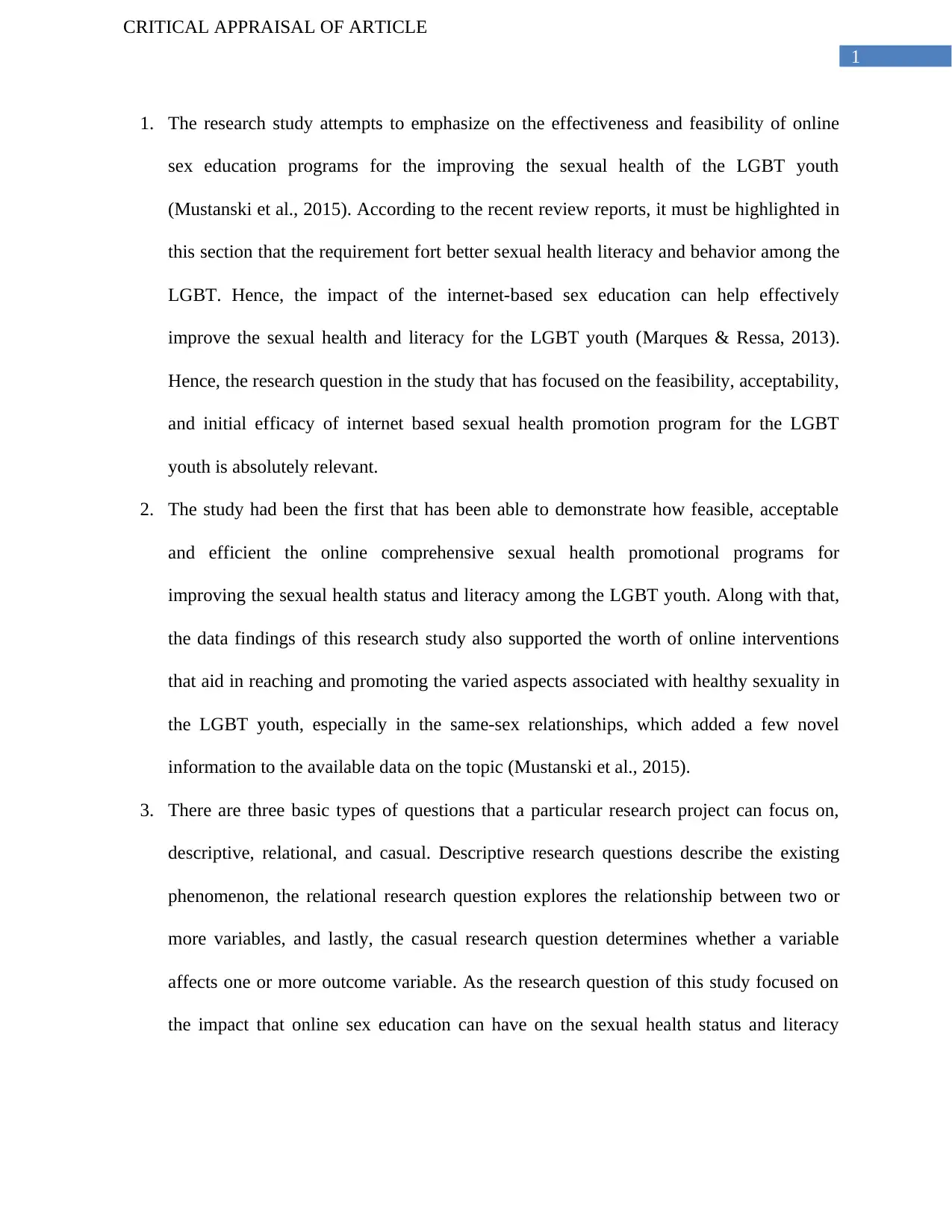
1
CRITICAL APPRAISAL OF ARTICLE
1. The research study attempts to emphasize on the effectiveness and feasibility of online
sex education programs for the improving the sexual health of the LGBT youth
(Mustanski et al., 2015). According to the recent review reports, it must be highlighted in
this section that the requirement fort better sexual health literacy and behavior among the
LGBT. Hence, the impact of the internet-based sex education can help effectively
improve the sexual health and literacy for the LGBT youth (Marques & Ressa, 2013).
Hence, the research question in the study that has focused on the feasibility, acceptability,
and initial efficacy of internet based sexual health promotion program for the LGBT
youth is absolutely relevant.
2. The study had been the first that has been able to demonstrate how feasible, acceptable
and efficient the online comprehensive sexual health promotional programs for
improving the sexual health status and literacy among the LGBT youth. Along with that,
the data findings of this research study also supported the worth of online interventions
that aid in reaching and promoting the varied aspects associated with healthy sexuality in
the LGBT youth, especially in the same-sex relationships, which added a few novel
information to the available data on the topic (Mustanski et al., 2015).
3. There are three basic types of questions that a particular research project can focus on,
descriptive, relational, and casual. Descriptive research questions describe the existing
phenomenon, the relational research question explores the relationship between two or
more variables, and lastly, the casual research question determines whether a variable
affects one or more outcome variable. As the research question of this study focused on
the impact that online sex education can have on the sexual health status and literacy
CRITICAL APPRAISAL OF ARTICLE
1. The research study attempts to emphasize on the effectiveness and feasibility of online
sex education programs for the improving the sexual health of the LGBT youth
(Mustanski et al., 2015). According to the recent review reports, it must be highlighted in
this section that the requirement fort better sexual health literacy and behavior among the
LGBT. Hence, the impact of the internet-based sex education can help effectively
improve the sexual health and literacy for the LGBT youth (Marques & Ressa, 2013).
Hence, the research question in the study that has focused on the feasibility, acceptability,
and initial efficacy of internet based sexual health promotion program for the LGBT
youth is absolutely relevant.
2. The study had been the first that has been able to demonstrate how feasible, acceptable
and efficient the online comprehensive sexual health promotional programs for
improving the sexual health status and literacy among the LGBT youth. Along with that,
the data findings of this research study also supported the worth of online interventions
that aid in reaching and promoting the varied aspects associated with healthy sexuality in
the LGBT youth, especially in the same-sex relationships, which added a few novel
information to the available data on the topic (Mustanski et al., 2015).
3. There are three basic types of questions that a particular research project can focus on,
descriptive, relational, and casual. Descriptive research questions describe the existing
phenomenon, the relational research question explores the relationship between two or
more variables, and lastly, the casual research question determines whether a variable
affects one or more outcome variable. As the research question of this study focused on
the impact that online sex education can have on the sexual health status and literacy
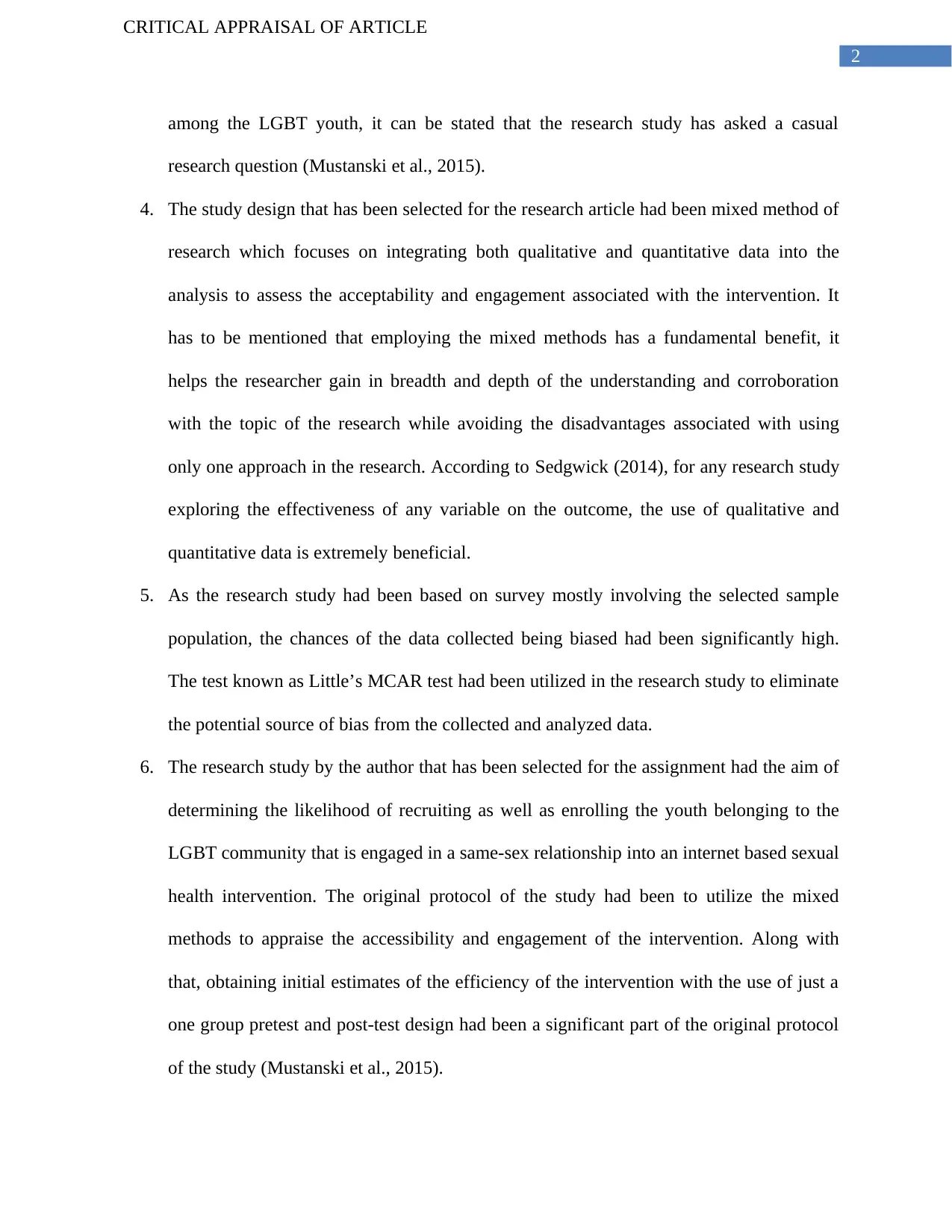
2
CRITICAL APPRAISAL OF ARTICLE
among the LGBT youth, it can be stated that the research study has asked a casual
research question (Mustanski et al., 2015).
4. The study design that has been selected for the research article had been mixed method of
research which focuses on integrating both qualitative and quantitative data into the
analysis to assess the acceptability and engagement associated with the intervention. It
has to be mentioned that employing the mixed methods has a fundamental benefit, it
helps the researcher gain in breadth and depth of the understanding and corroboration
with the topic of the research while avoiding the disadvantages associated with using
only one approach in the research. According to Sedgwick (2014), for any research study
exploring the effectiveness of any variable on the outcome, the use of qualitative and
quantitative data is extremely beneficial.
5. As the research study had been based on survey mostly involving the selected sample
population, the chances of the data collected being biased had been significantly high.
The test known as Little’s MCAR test had been utilized in the research study to eliminate
the potential source of bias from the collected and analyzed data.
6. The research study by the author that has been selected for the assignment had the aim of
determining the likelihood of recruiting as well as enrolling the youth belonging to the
LGBT community that is engaged in a same-sex relationship into an internet based sexual
health intervention. The original protocol of the study had been to utilize the mixed
methods to appraise the accessibility and engagement of the intervention. Along with
that, obtaining initial estimates of the efficiency of the intervention with the use of just a
one group pretest and post-test design had been a significant part of the original protocol
of the study (Mustanski et al., 2015).
CRITICAL APPRAISAL OF ARTICLE
among the LGBT youth, it can be stated that the research study has asked a casual
research question (Mustanski et al., 2015).
4. The study design that has been selected for the research article had been mixed method of
research which focuses on integrating both qualitative and quantitative data into the
analysis to assess the acceptability and engagement associated with the intervention. It
has to be mentioned that employing the mixed methods has a fundamental benefit, it
helps the researcher gain in breadth and depth of the understanding and corroboration
with the topic of the research while avoiding the disadvantages associated with using
only one approach in the research. According to Sedgwick (2014), for any research study
exploring the effectiveness of any variable on the outcome, the use of qualitative and
quantitative data is extremely beneficial.
5. As the research study had been based on survey mostly involving the selected sample
population, the chances of the data collected being biased had been significantly high.
The test known as Little’s MCAR test had been utilized in the research study to eliminate
the potential source of bias from the collected and analyzed data.
6. The research study by the author that has been selected for the assignment had the aim of
determining the likelihood of recruiting as well as enrolling the youth belonging to the
LGBT community that is engaged in a same-sex relationship into an internet based sexual
health intervention. The original protocol of the study had been to utilize the mixed
methods to appraise the accessibility and engagement of the intervention. Along with
that, obtaining initial estimates of the efficiency of the intervention with the use of just a
one group pretest and post-test design had been a significant part of the original protocol
of the study (Mustanski et al., 2015).
⊘ This is a preview!⊘
Do you want full access?
Subscribe today to unlock all pages.

Trusted by 1+ million students worldwide
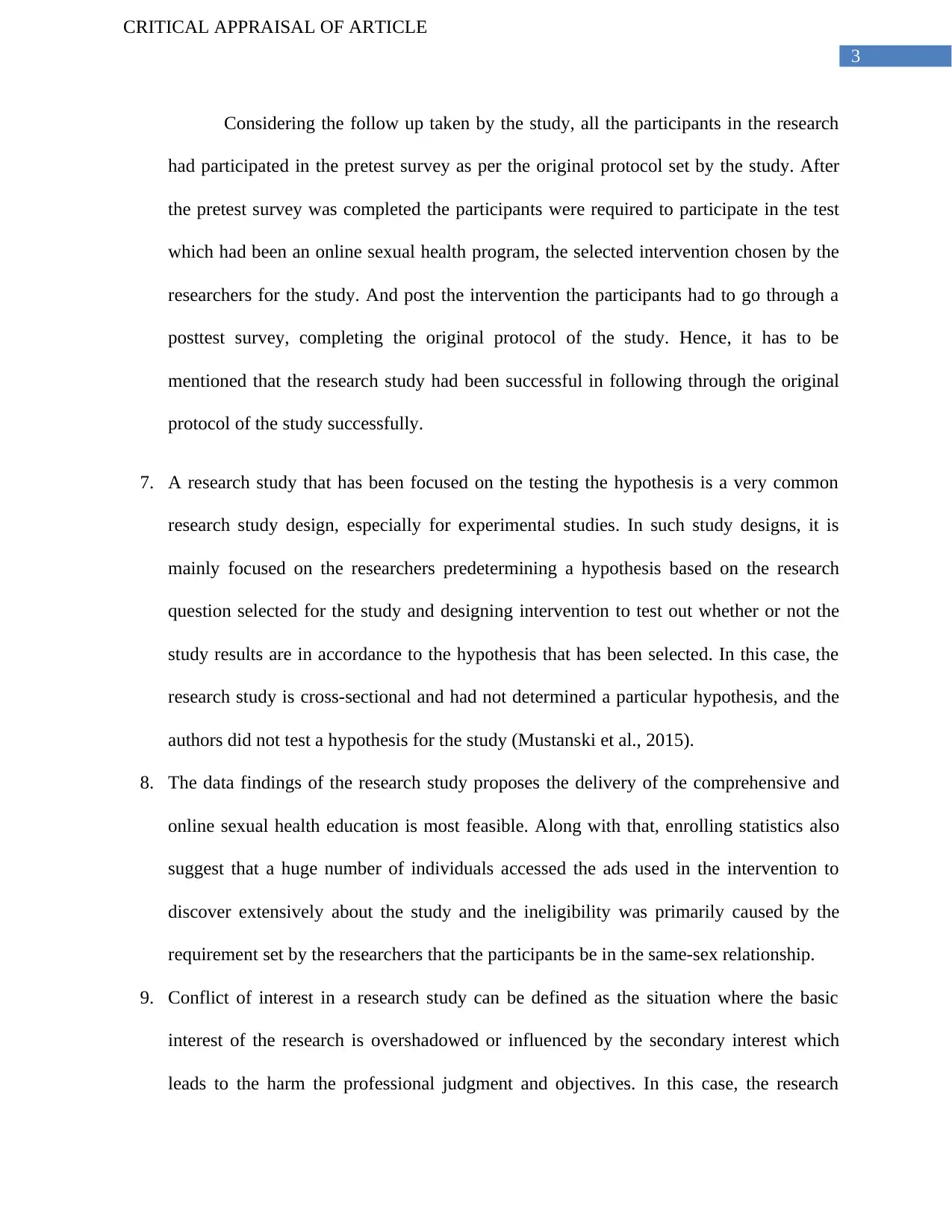
3
CRITICAL APPRAISAL OF ARTICLE
Considering the follow up taken by the study, all the participants in the research
had participated in the pretest survey as per the original protocol set by the study. After
the pretest survey was completed the participants were required to participate in the test
which had been an online sexual health program, the selected intervention chosen by the
researchers for the study. And post the intervention the participants had to go through a
posttest survey, completing the original protocol of the study. Hence, it has to be
mentioned that the research study had been successful in following through the original
protocol of the study successfully.
7. A research study that has been focused on the testing the hypothesis is a very common
research study design, especially for experimental studies. In such study designs, it is
mainly focused on the researchers predetermining a hypothesis based on the research
question selected for the study and designing intervention to test out whether or not the
study results are in accordance to the hypothesis that has been selected. In this case, the
research study is cross-sectional and had not determined a particular hypothesis, and the
authors did not test a hypothesis for the study (Mustanski et al., 2015).
8. The data findings of the research study proposes the delivery of the comprehensive and
online sexual health education is most feasible. Along with that, enrolling statistics also
suggest that a huge number of individuals accessed the ads used in the intervention to
discover extensively about the study and the ineligibility was primarily caused by the
requirement set by the researchers that the participants be in the same-sex relationship.
9. Conflict of interest in a research study can be defined as the situation where the basic
interest of the research is overshadowed or influenced by the secondary interest which
leads to the harm the professional judgment and objectives. In this case, the research
CRITICAL APPRAISAL OF ARTICLE
Considering the follow up taken by the study, all the participants in the research
had participated in the pretest survey as per the original protocol set by the study. After
the pretest survey was completed the participants were required to participate in the test
which had been an online sexual health program, the selected intervention chosen by the
researchers for the study. And post the intervention the participants had to go through a
posttest survey, completing the original protocol of the study. Hence, it has to be
mentioned that the research study had been successful in following through the original
protocol of the study successfully.
7. A research study that has been focused on the testing the hypothesis is a very common
research study design, especially for experimental studies. In such study designs, it is
mainly focused on the researchers predetermining a hypothesis based on the research
question selected for the study and designing intervention to test out whether or not the
study results are in accordance to the hypothesis that has been selected. In this case, the
research study is cross-sectional and had not determined a particular hypothesis, and the
authors did not test a hypothesis for the study (Mustanski et al., 2015).
8. The data findings of the research study proposes the delivery of the comprehensive and
online sexual health education is most feasible. Along with that, enrolling statistics also
suggest that a huge number of individuals accessed the ads used in the intervention to
discover extensively about the study and the ineligibility was primarily caused by the
requirement set by the researchers that the participants be in the same-sex relationship.
9. Conflict of interest in a research study can be defined as the situation where the basic
interest of the research is overshadowed or influenced by the secondary interest which
leads to the harm the professional judgment and objectives. In this case, the research
Paraphrase This Document
Need a fresh take? Get an instant paraphrase of this document with our AI Paraphraser
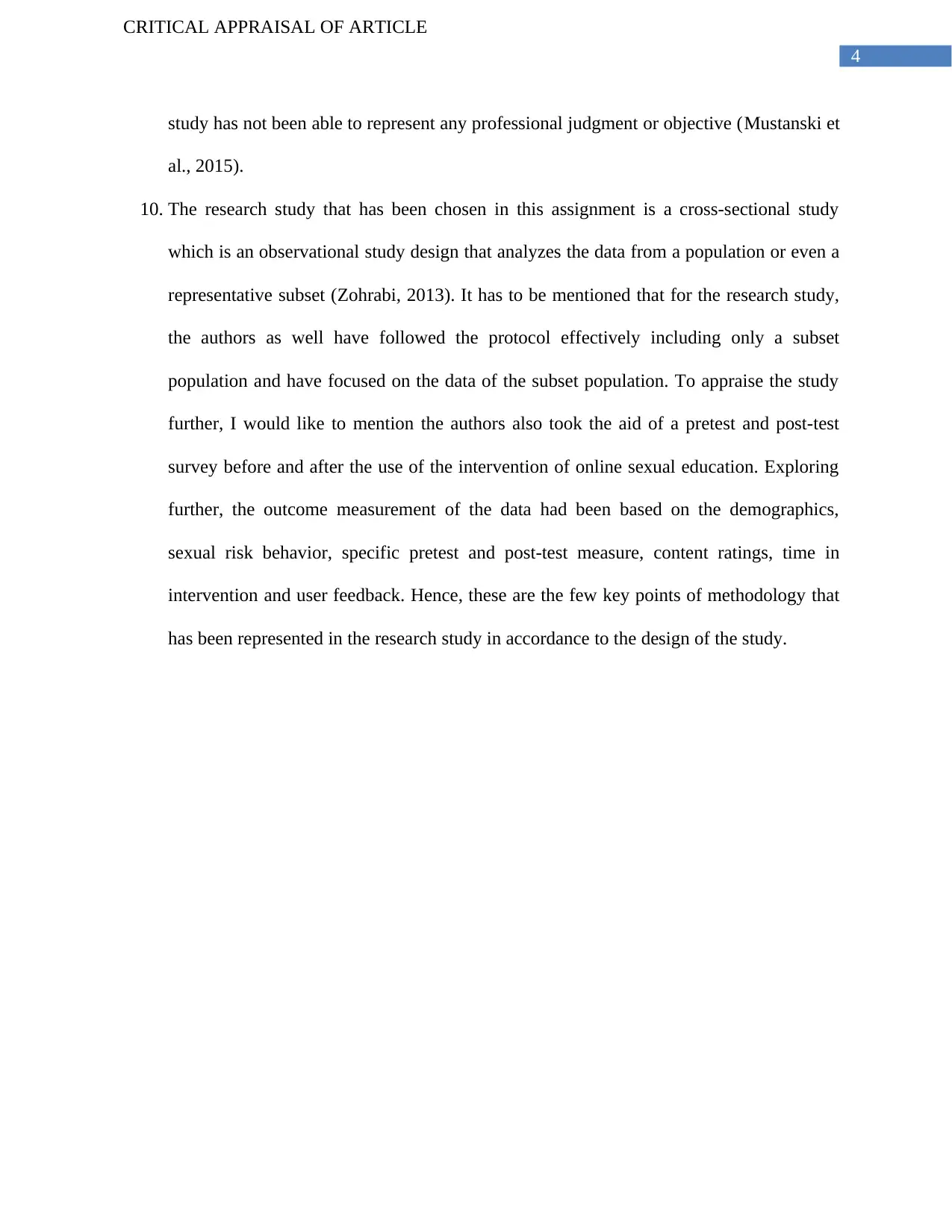
4
CRITICAL APPRAISAL OF ARTICLE
study has not been able to represent any professional judgment or objective (Mustanski et
al., 2015).
10. The research study that has been chosen in this assignment is a cross-sectional study
which is an observational study design that analyzes the data from a population or even a
representative subset (Zohrabi, 2013). It has to be mentioned that for the research study,
the authors as well have followed the protocol effectively including only a subset
population and have focused on the data of the subset population. To appraise the study
further, I would like to mention the authors also took the aid of a pretest and post-test
survey before and after the use of the intervention of online sexual education. Exploring
further, the outcome measurement of the data had been based on the demographics,
sexual risk behavior, specific pretest and post-test measure, content ratings, time in
intervention and user feedback. Hence, these are the few key points of methodology that
has been represented in the research study in accordance to the design of the study.
CRITICAL APPRAISAL OF ARTICLE
study has not been able to represent any professional judgment or objective (Mustanski et
al., 2015).
10. The research study that has been chosen in this assignment is a cross-sectional study
which is an observational study design that analyzes the data from a population or even a
representative subset (Zohrabi, 2013). It has to be mentioned that for the research study,
the authors as well have followed the protocol effectively including only a subset
population and have focused on the data of the subset population. To appraise the study
further, I would like to mention the authors also took the aid of a pretest and post-test
survey before and after the use of the intervention of online sexual education. Exploring
further, the outcome measurement of the data had been based on the demographics,
sexual risk behavior, specific pretest and post-test measure, content ratings, time in
intervention and user feedback. Hence, these are the few key points of methodology that
has been represented in the research study in accordance to the design of the study.
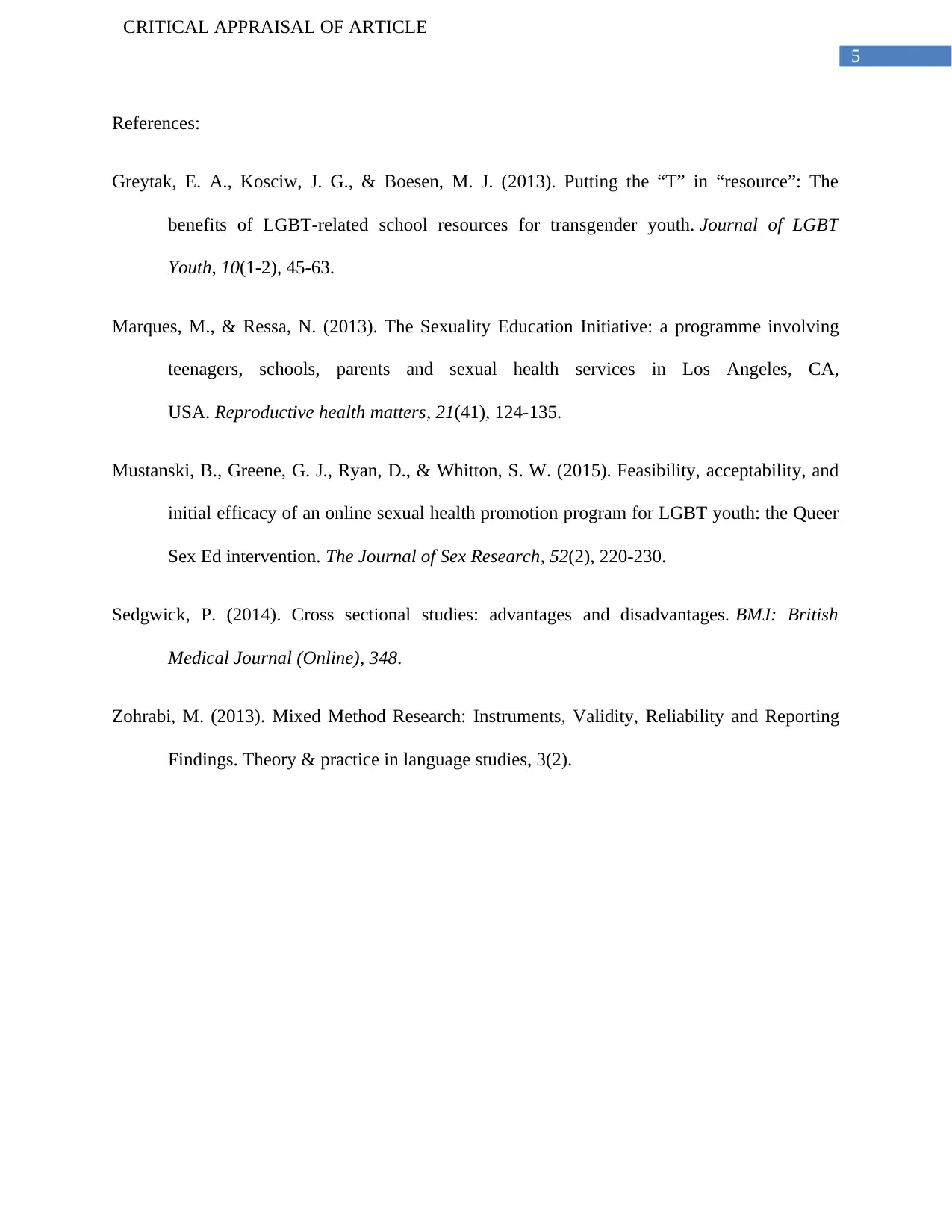
5
CRITICAL APPRAISAL OF ARTICLE
References:
Greytak, E. A., Kosciw, J. G., & Boesen, M. J. (2013). Putting the “T” in “resource”: The
benefits of LGBT-related school resources for transgender youth. Journal of LGBT
Youth, 10(1-2), 45-63.
Marques, M., & Ressa, N. (2013). The Sexuality Education Initiative: a programme involving
teenagers, schools, parents and sexual health services in Los Angeles, CA,
USA. Reproductive health matters, 21(41), 124-135.
Mustanski, B., Greene, G. J., Ryan, D., & Whitton, S. W. (2015). Feasibility, acceptability, and
initial efficacy of an online sexual health promotion program for LGBT youth: the Queer
Sex Ed intervention. The Journal of Sex Research, 52(2), 220-230.
Sedgwick, P. (2014). Cross sectional studies: advantages and disadvantages. BMJ: British
Medical Journal (Online), 348.
Zohrabi, M. (2013). Mixed Method Research: Instruments, Validity, Reliability and Reporting
Findings. Theory & practice in language studies, 3(2).
CRITICAL APPRAISAL OF ARTICLE
References:
Greytak, E. A., Kosciw, J. G., & Boesen, M. J. (2013). Putting the “T” in “resource”: The
benefits of LGBT-related school resources for transgender youth. Journal of LGBT
Youth, 10(1-2), 45-63.
Marques, M., & Ressa, N. (2013). The Sexuality Education Initiative: a programme involving
teenagers, schools, parents and sexual health services in Los Angeles, CA,
USA. Reproductive health matters, 21(41), 124-135.
Mustanski, B., Greene, G. J., Ryan, D., & Whitton, S. W. (2015). Feasibility, acceptability, and
initial efficacy of an online sexual health promotion program for LGBT youth: the Queer
Sex Ed intervention. The Journal of Sex Research, 52(2), 220-230.
Sedgwick, P. (2014). Cross sectional studies: advantages and disadvantages. BMJ: British
Medical Journal (Online), 348.
Zohrabi, M. (2013). Mixed Method Research: Instruments, Validity, Reliability and Reporting
Findings. Theory & practice in language studies, 3(2).
⊘ This is a preview!⊘
Do you want full access?
Subscribe today to unlock all pages.

Trusted by 1+ million students worldwide
1 out of 6
Related Documents
Your All-in-One AI-Powered Toolkit for Academic Success.
+13062052269
info@desklib.com
Available 24*7 on WhatsApp / Email
![[object Object]](/_next/static/media/star-bottom.7253800d.svg)
Unlock your academic potential
Copyright © 2020–2025 A2Z Services. All Rights Reserved. Developed and managed by ZUCOL.




